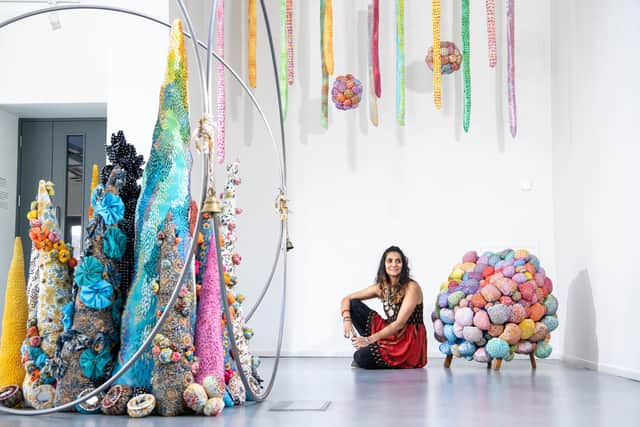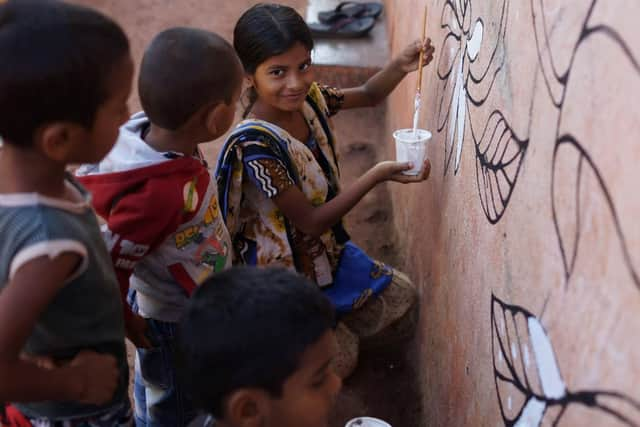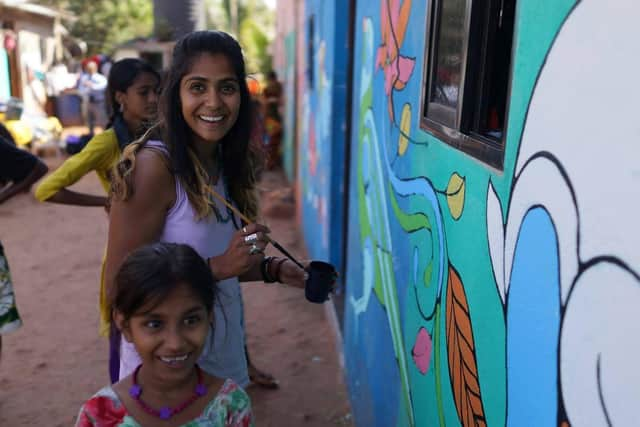Saroj Patel: Emotional exhibition of colour, texture and patterns inspired by Indian heritage
When Saroj Patel walked into the Art House in Wakefield and saw her monumental textile sculptures in place together for the first time she admits she cried. “It has taken me a long time to get here and it was really emotional especially that my first solo show was in the north and my parents could be there.”
The British Indian textile artist draws on ritualistic and cultural traditions to create sculptures that celebrate community, Indian culture and her personal upbringing. Her debut solo project presents large-scale hanging sculptures suspended from the ceiling that present stories that expand on ritualistic practices, myths, Indian astrology, migration, race, identity and gender.
Advertisement
Hide AdAdvertisement
Hide AdInterwoven, Patel’s first major solo exhibition, also offers visitors the opportunity to see brand-new work co-created in collaboration with local Wakefield residents and members of The Art House’s Studio of Sanctuary. An awardee of the Haribo Togetherness Grant, Patel created family workshops offering the chance to explore what togetherness means, whilst learning about each other’s cultures and traditions.


“I’m passionate about working with communities and I’ve done so throughout my career,” says Patel. “I originally applied to the Art House to do work with their refugees and asylum seekers. I am really interested in migration because of my parents. I was lucky enough to be chosen and that’s how I got to know the Art House curator Amelia [Baron] who saw my work and said she thought it would be amazing to have it as a solo show.
"I was really pleased. I’ve been doing a lot of shared exhibitions in London, but I am from the north and so it was so nice that my first solo show was up north. It meant my parents and my husband’s parents could come.”
Growing up a woman in a British Indian family in the north there weren’t many opportunities for her to follow her creative passion, she says.
Advertisement
Hide AdAdvertisement
Hide Ad"I was always really artistic and my art teacher at school was really encouraging and said I should continue, but I had no peers who did art and it just wasn’t something anyone did so I ended up doing computer science in my first year of university, but then changed to graphic design.” From graphic design she got into illustration and painting, but it wasn’t until she did an MA in Fine Art at Central St Martin’s, London that she found her true calling.


"Coming from an Indian family when you get to a certain age you feel you should buy a house. I’d saved a bit of money and I went to my dad and I said rather than buying a house I would love to do an MA n Fine Art – my parents were amazing. They were so supportive and said of course.
"It was probably the best thing I did. It wasn’t until the final term of my two year course that I realised that working with textiles was something that I was really meant to do. I love pattern, I love colour and I love texture. It allowed me to explore my heritage. When I started working with textiles and fabric it came so easy to me, I have endless amounts of ideas.
“Fabric as a form is really adaptable and translates into many languages. People wear them as clothing which is a really important part of someone’s identity. It was a really material to use as a form of language. When I think of Indian culture one of the big things is the clothes people wear.
Advertisement
Hide AdAdvertisement
Hide Ad"My parents came from a poor background and a lot of the women in those villages still wear traditional Indian dress. They are working the fields wearing these beautiful brightly coloured saris pinks and blues which contrast with the green fields – they are a real inspiration for my work."


Mother of three-year-old twins Patel uses saris in some of her work.
"A lot of my sculptures come about from what material is available at the time. My mum had loads of saris and I thought what a brilliant way to use these fabrics.”
Interestingly, Petal makes her monumental installations in sections which aren’t put together until they are assembled in the exhibition space. So when she walked into the Art House gallery it was the first time she had seen her work completed as it had been constructed by Amelia.
Advertisement
Hide AdAdvertisement
Hide Ad"When I started making the installations I had a very small space to work in. I think of everything as little bits made up into one large piece. I tend to start with one little sculpture and go bigger and bigger. I am very good at envisaging what the finished sculptures will look like.
"It was so nice that Amelia unpacked and installed everything as normally I have to do and it takes such a long time. She did such a fantastic job.”
Patel has also started to incorporate objects into her sculptures including bells, symbols, glass beads, old clothes, steel, and ceramic beans – all rooted in Indian traditions.
"Before I moved into textile sculptures I painted murals and I had lots of paint left over so I also use that in some of my pieces. I have this material how can I use it in completely different ways.”
Advertisement
Hide AdAdvertisement
Hide AdPatel still paints murals, but mainly when she works with villages and communities in India. “I’ve always been drawn to working with people – I get so much out of it myself. I did these painting workshops in India I could easily have been born in these villages myself if my grandfather and parents hadn’t moved over here. So I wanted to give them an opportunity to paint.
"I am a big believer in education but they don’t have art as a class in schools. I then approached even poorer disadvantaged communities as a way to engage with them and once you start they just open up and then invite you their houses. I learnt so much about how they live, their school, how they pay for their school and why they might not go to school.
"I feel really connected when I go there and it made me realised that I have the opportunity to make a difference to people’s lives even if just in a small way.”
After working with groups in India she decided to work with disadvantaged groups in the UK. "Being creative and when you are making things it gives people the opportunity to relax and enjoy themselves and open up"
Advertisement
Hide AdAdvertisement
Hide AdThe Wakefield workshops saw Patel work with intergenerational disadvantaged communities where many children of refugees and asylum seekers from all over the world who have been out of the school system for a long period of time.
They worked together to create one textile piece which is now handing in the stair case at the Art House, between the Sanctuary workshop space and the gallery which will be on display over the summer.”
“What I would like to do as I develop my career I would love to do more in India and create more opportunities for people in the arts in these kind of villages. My dad is involved in a school there already – my parents inspire me to work with communities,” says Patel, who is also busy creating new works for a London solo exhibition later this month.
"It is a very busy but very exciting time for me and I just hope I can inspire other women from Indian backgrounds to pursue their passion for art,” she adds.
Saroj Patel: Interwoven at the Art House, Wakefield until 25 April.
Comment Guidelines
National World encourages reader discussion on our stories. User feedback, insights and back-and-forth exchanges add a rich layer of context to reporting. Please review our Community Guidelines before commenting.